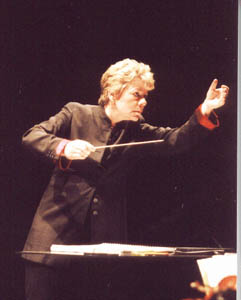![[Metroactive Music]](/music/gifs/music468.gif)
[ Music Index | Silicon Valley | Metroactive Home | Archives ]
From Tango to Klezmer
The Cabrillo Festival of Contemporary Music ranged from Buenos Aires to Odessa in
final weekend
By Scott MacClelland
BY WHAT strange odds could the first two pieces on the Cabrillo Festival of Contemporary Music's Saturday program in Santa Cruz be imbued with both tango and klezmer? John Mackey's Redline Tango, in its West Coast premiere, and Stewart Wallace's Skvera, in the premiere of its revised version, each found ways to introduce Buenos Aires to the Odessa ghetto. While there may have been a more personal rationale in the Wallace piece, the Mackey made a more coherent impression, and in fewer than 10 minutes as against the 30-minute Wallace attempt.
Mackey's success was due in part to his embrace of tried-and-true classical form. Write a piece that's weaker in formal coherency and the audience has to work that much harder to capture the experience in memory. That's what afflicted the Wallace piece, nominally a concerto for electric guitar. Its lack of coherency was most obvious in the discrepancy between the solo, played ferociously by John Zorn�collaborator Marc Ribot, and the orchestral score. The two might have been ships passing in the night (but not for want of blaring foghorns).
However, since each of the four movements—titled Road Trip, Cemetery Factory, Synagogue Factory and Blind Woman Hashkiveinu—had a character unto itself, hearing this sentimental journey to a small Ukrainian village without the guitar whets the imagination.
The program ended with the festival premiere of John Adams' 42-minute Harmonielehre, a 1985 commentary on a treatise of the same name by Arnold Schoenberg. In affirming tonal harmony, however, it opens and closes with a more obvious tribute to the Steve Reich brand of minimalism. Memorable for the soaring violin melodies that emerge out of the Reichian tyranny, the return to minimalism in the closing minutes makes one of the most common mistakes of orchestral composition over the last two decades: piling on the winds, brass and percussion until the strings in all their desperate activity are completely drowned out.
The middle movement, titled "The Amfortas Wound," was the best, opening with doleful cello and trumpet solos and rising to a climax in paraphrase of a similar climax in the first movement of Mahler's unfinished 10th Symphony. At Mission San Juan Bautista on Sunday, Dominick Argento's Reflections on a Hymn Tune reiterated tonality, classical structure and romantic gesture all with an authoritative hand. It grew in scale and intensity on its way to clear cadences and a grand Hindemithian climax, pausing briefly to allow the hymn to be vocalized softly by members of the orchestra. Aaron Jay Kernis' Air spotlighted cellist Lee Duckles in its highly personal solo rumination.
Magnus Lindberg's 30-minute Concerto for Orchestra is a regular tour de force, a monsterpiece and gutsy for its deliberate shortfall of repetition, that element most composers depend on to provide their listeners with the thread through the labyrinth. Not here, however, as the piece put on a riotous pageant of sounds and effects that showed off the extraordinary Cabrillo musicians in blazing fanfares, quiet solo cameos and thundering ensembles—occasionally guilty like the Adams of blotting out the strings.
[ Silicon Valley | Metroactive Home | Archives ]
![]()

In Charge: Marin Alsop led the Cabrillo Festival to a tour-de-force climax in San Juan Bautista.
Send a letter to the editor about this story to letters@metronews.com.
From the August 17-23, 2005 issue of Metro, Silicon Valley's Weekly Newspaper.